It’s inescapable—people need visuals. Our brains process visuals 60,000 times faster than text. Content containing compelling visuals garners 94 percent more views than content without images (Walter & Gioglio, 2014). In the 1980s, newsrooms began to understand the impact of images when improved visuals and color printing became accessible.
This led to W.E.D., the marriage of three disciplines: writing, editing, and design. Mario García explained the goal, “With WED, we made sure that design existed to make content more accessible and visually appealing.”
Today W.E.D. is commonplace in newsrooms. García writes, “A reporter plans how the story will be presented sitting side by side with a visual journalist. We are talking visual journalism here, which continues to involve the use of photos, videos, infographics, but not as an appendix to the story, but woven into the texture of it.”
Newsrooms have started to wield W.E.D. in tandem with Solutions Journalism. Nicole Dahmen, Associate Professor at the University of Oregon School of Journalism and Communication, defines Solutions Journalism as “a fact-based, rigorous reporting method aimed at covering workable responses to societal problems.”
Reader and viewer desire precipitated the newsroom shift toward solutions. Emily Kasriel explained the BBC’s shift in focus. “the desire to better serve our audiences, particularly young people. According to recent BBC Audience Research, 51% of 16-18 year olds and 47% of 19-24 year olds in the UK ‘agree or strongly agree’ that they want news to also provide solutions. The figures were even higher in the developing world: 75% of Indians, 78% of Nigerians and 82% of Kenyans of all ages want their news to provide solutions and not just problems.”
This past week, I tried my hand at a solutions-based photo essay. A photo essay is a collection of photos with a theme that, when taken as a whole, form a larger narrative or story.
Photo Essay: Don’t Take Life Sitting Down
Do you work in an office? Yes, are you seated for most of the day? Okay, do you exercise regularly? According to the Centers for Disease Control and Prevention (CDC), approximately, thirty-nine percent of Americans are obese, and only about half (51.7 %) meet national aerobic guidelines. This photo essay explores the challenge facing office or information workers.
My Rationale
For my photo essay, I decided to continue the theme of a sedentary lifestyle. The topic is relevant to me. Recently, I felt that I needed to be more active, especially as the summer ends. At my office, discussions about going for walks and eating habits are prevalent topics around the water cooler.
My inspiration for the photos came from a walk after work, where I was surprised by all the seating that I found around downtown Albany, NY (the city where I work). Every block I walked had some form of seating. I stopped and thought about the enormous amount of sitting I do in a day. I go from sitting at home, to sitting in my car, to sitting at my desk, to sitting in the breakroom, to sitting in my car heading home and to sitting on the couch before I go to bed and start the cycle over.
Technique
In photography, capturing moments—capturing a climax in action or emotion—is the goal. I took a slightly different approach for this project. I wanted my photos to be devoid of characters (or people)—the only photo to have a person is the seventh photo, but it only includes a pair of nondescript feet and legs (mine).
My concept was to allow viewers to picture themselves going through an example of the sedentary life of an information worker and the ongoing struggle to reverse the trend and lead an active lifestyle. I wanted it to be immersive, relatable, instructive, and simple. As Françoise Mouly, the editor of the New Yorker, says, “A simple image can speak volumes.”
Image-by-Image
Below is a breakdown of each image contained in the essay.
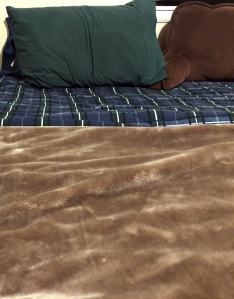
The Bed
This photo is intended to highlight the position of the body during sleep. Distance is an overlooked aspect of photography. Mike Davis, an educator and former National Geographic picture editor, says, “You tend to not think about ‘how far away we are’ as an aspect of conveying something about what we are photographing. It’s usually, ‘I need to stand this far away from something to show it.”
I used distance and composition to tell the story. The camera position is where a person’s feet would be, and the focus of the shot is the pillow where the head would reside. Upon reflection, this photo could have been more effective if I had taken a picture of an unmade bed.

The couch
This image’s focus is the center of the couch where an office worker would sit rather than the couch itself. This is accomplished by the angle of the camera, low and close—looking down on the seat. This image also tells a story of being sedentary. The center couch, where someone would sit, is surrounded by remote controls on either side. The location and proximity of the remotes allows viewers to infer that someone spends a lot of time watching television.

Parking Garage
I love subtle details in the image. The composition tells the story. The entrance to the parking garage is the upper left, and the center of the image is a bench directly outside. If someone gets winded walking out of the garage, there’s a convenient bench for him to catch his breath and have a cigarette – there are half a dozen cigarette butts in front of the bench. Looking at this image, I can visualize someone walking from the garage and stopping for a smoke.

Workstation
This photo is also rich with subtle detail that tells a story about sedentary work. The lower perspective of the camera focuses the image on where an information worker’s body would be. The center of the image includes a chair and two monitors, which tells us that this person stares at screens all day. To the left of the chair, is another seat, a cushion on the top of the desk drawers. The direction the chair adds another element to this picture’s story. It’s pointed toward the window and the picture’s source of natural light. I can imagine a worker staring wistfully out the window.

Local Park
Even out of the context of my narrative, this image tells a story of a sedentary lifestyle. In this photo of a local park, I was able to capture eight chairs and five tables in a single photo. The first thing that strikes me about this image is the number of places to sit. One can hardly take a step without reaching a place to take a seat. The photo raises the question, can people enjoy a park while standing?

Take a Step
This photo is the act of taking a step. The focus on the feet tells viewers that this image is about action, walking. This is accomplished by showing only the lower extremities against a bland background (part of a garage).

Stairs
The low angle of this image tells a story of challenge—it makes climbing the stairs feel like a daunting proposition. The purpose of the photo was information: stairs are all around us, and we should use them.
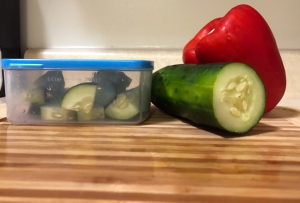
Vegetables
This image’s story is that we should eat more vegetables and pack nutritious snacks. The image is light and includes bright colors making it inviting. The container on the left tells that vegetables are portable and suggests we bring them with us.
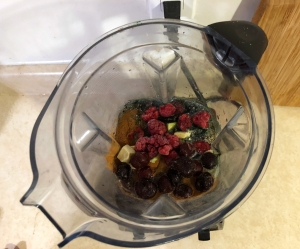
Smoothie
This is another fact-based photo. My goal was to demonstrate that smoothies are a simple way to include fruit and vegetables in one’s diet.
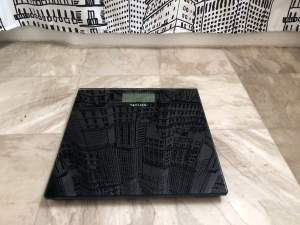
Scale
The last photo in my essay is another simple, fact-based photo of a scale. For most people, scales have an unpleasant connotation that is associated with weight gain. This image tells a story about bodyweight management. Hopefully, if you follow the simple suggestions of the preceding photos, you can lose weight and become healthier.
References
Campbell, D. (2018, January 22). Why it’s time for visual journalism to include a solutions focus. Retrieved from https://witness.worldpressphoto.org/why-it-is-time-for-visual-journalism-to-include-a-solutions-focus-5be15aec3afc
Dahmen, N. (2017, November 22). How to do better visual journalism for solutions stories. Retrieved from http://mediashift.org/2017/11/visually-reporting-solutions-stories-newsrooms-classrooms/
Garcia, M. (2017, January 19). Digital storytelling, part one: The fusion of writing/editing/design. Retrieved from https://www.garciamedia.com/blog/digital_storytelling_part_one_the_fusion_of_writing_editing_design/
Gitner, S. (2015). Visual storytelling in what ways do we think about visual storytelling every day? Multimedia storytelling for digital communicators in a multiplatform world (1st ed., pp. 1-33). New York, NY: Routledge.
Kasriel, E. (2016, August 31). Why we need solutions-focused journalism. Retrieved from https://www.bbc.co.uk/blogs/academy/entries/be8991c7-c1c7-42e6-a371-f40278838fa2
Shurbaji, E. (2014, December 17). Photo narratives: defining picture stories, essays and packages. Retrieved from https://medium.com/learning-journalism-tech/photo-narratives-d77b812f99dd
Walter, E., & Gioglio, J. (2014). The power of visual storytelling: How to use visuals, videos, and socail media to market your brand (1st ed.) McGraw-Hill Education.



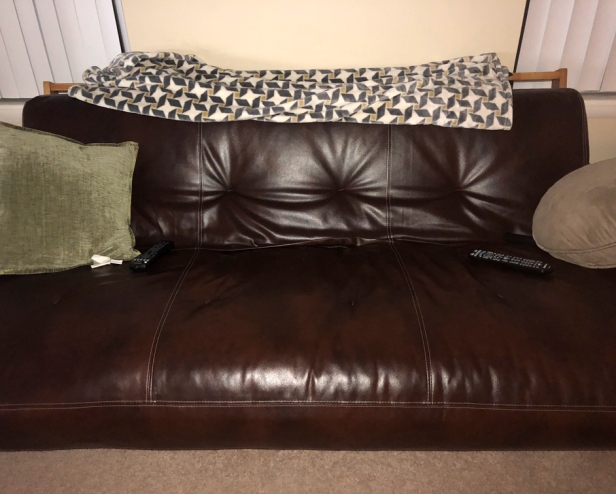




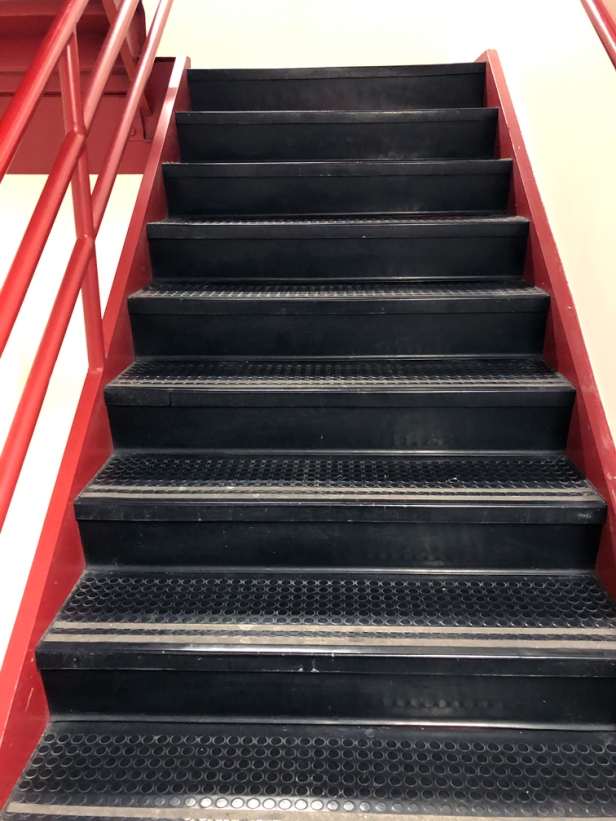



Michael, I REALLY liked the story behind your photo essay. As a working adult who is also working a desk job I can’t tell you how often I think of ways I can get out of my chair and moving. This is an issue that so many people in the United States face on a daily basis. I agree that your approach of using images without people helps viewers feel like the photos are from their prospective.
As for the photos, they are good but I have a couple of suggestions for changing the views using some of the different photo techniques we learned about from this week that would add more interest to the eye.
For the photo of the bed, I agree I would make it look like someone just rolled out of bed. But I would have taken the photo with the camera resting on the end of the pillow looking down to where the feet are. It gives the perspective of someone who is just waking up.
I would have sat in one of the chairs when taking the photo for the table and chairs for the lunch time photo because you can take it from the perspective of someone sitting at the table itself. This image uses the grouping Gestalt principle because we group the table and chairs together.
For the stairs photo, I think it would have been interesting to get down to the lowest stair level and the photo close-up and looking up or to go to the very top stair and look down at the steps. This photo is a good example of the continuation and the similarity Gestalt principles.
It feels like you need a conclusion to close out your photo essay, perhaps discussing how how you incorporated some of the different Gestalt principles into some of the photos and how you hope that this photo essay helped people realize they need to change their ways. But nice work here!
LikeLike
Hi Michael,
I appreciate the fact that you chose a subject for your solution-focused photo essay that impacts literally everyone on the face of the earth in 2019. As a whole, humans have become a lot more sedentary since many jobs require desk work and/or minimal labor. I, too, have been feeling the need to get more active – it’s just so hard to do that when you have work, school, and life going on all at once!
While I think the topic, the rationale paragraph, and the break down of your technique were great, I felt that the photo essay itself really lacked a story or a soul. The photo essay seems more like a collection of pictures with corresponding captions. For me, one sentence per photo does not equate to an essay.
I would have loved to have seen the second paragraph of your rationale section and bits from your technique section integrated into your photo essay because it gives perspective and context. I also might reconsider reformatting the introduction to your photo essay. It is super heavy with citations that I’m not sure add much (for example, the BBC Audience statistic) to the post and it doesn’t transition well to the topic of sedentary lifestyle/weight management. If this were to be revised, I would put more emphasis on the photo essay itself and then support it with secondary information like the W.E.D. concept/techniques.
Good job on executing this multifaceted assignment.
– Alex
LikeLike